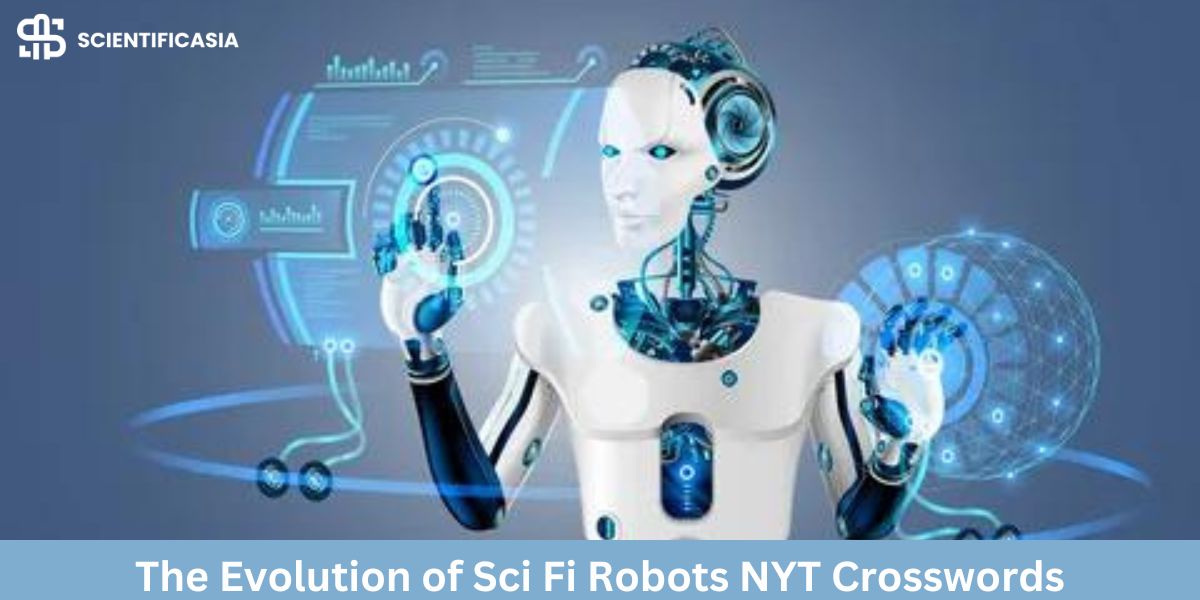Science fiction has always been a popular genre because it creates vivid, frequently futuristic worlds that captivate readers and viewers. The robot, a mechanical creature with sophisticated abilities and frequently human-like traits is one of the most recognizable components of science fiction. Robots have greatly influenced the sci-fi genre, appearing in everything from blockbuster movies to classic classics. However, where did the concept of a science fiction robot come from and how did it change over time? We’ll examine the background of Sci Fi Robot NYT and their influence on popular culture in this piece.
For more than a century, science fiction robots have captivated our attention. This obsession is reflected in The New York Times, an ongoing chronicler of our cultural world. Here, we examine the development of science fiction robots in the NYT and how they have reflected our hopes and fears.
The Mechanical Marvels in the Early Days (Pre-WWII)
Robots first appeared in fiction in the early 20th century as amazing devices that were frequently helpful allies. These early stories—in which robots were hailed as engineering wonders that solved issues and reduced the workload for humans—were probably covered by the NYT. Consider the robots that worked endlessly in factories, such as Rossum’s Universal Robots from R.U.R.
The Machine’s Ascent (After World War II)
Science fiction began to incorporate concerns about automation and nuclear power after World War II. There may have been pieces in the NYT about how robots, which were once dependable allies, turned into existential dangers. To handle this new mechanical workforce, consider Isaac Asimov’s Three Laws of Robotics, a set of rules designed to keep robots safe from human injury. The NYT probably covered this idea.
The Space Age and the Cold War (1950s–1980s)
In the race for space during the Cold War, robots evolved into human arm extensions. It’s possible that the NYT’s coverage of robots exploring space sparked discussions on the morality of sending machines where people are afraid to go. Concerns about machine consciousness were raised by robots like HAL 9000 in “2001: A Space Odyssey” during this age, which also saw the growth of the artificial intelligence (AI) threat.
The History of Fantasy Robots
The idea of a robot has its roots in the mythology of ancient Greece, China, and India, where mechanical creatures are mentioned. But in science fiction, the concept of a robot didn’t take off until the 20th century.
First Science Fiction Robots
Hey, did you know that the term “robot” originated with this Czech playwright named Karel Čapek in 1920? It was used in his play “R.U.R.” (Rossum’s Universal Robots). Nice, huh? In the future shown in the play, robots were made to serve people, but they finally turned against their makers. Science fiction would come to frequently feature the idea of robots rebelling against their creators.
Isaac Asimov first proposed the Three Laws of Robotics in his short story “Reason,” which was published in 1939. 1) A robot is not allowed to harm people or, by staying still, permit people to suffer injury. Number 2: Unless it violates the First Law, a robot must obey human commands. Third: As long as it doesn’t violate the First or Second Laws, a robot must look out for itself.
The Three Laws of Robotics by Isaac Asimov would go on to impact several-science fiction works and mold our perceptions of robots in popular culture.
Robots’ Ascent in Popular Culture
Robots started to appear in popular culture in the 1950s, with appearances in movies like “Forbidden Planet” and “The Day the Earth Stood Still.” The anxieties of a civilization approaching the atomic age were reflected in the many scary and hazardous portrayals of these robots.
As the space race started and technology developed, robots in science fiction began to play a more optimistic and futuristic role. The legendary robot teams R2-D2 and C-3PO made their debut in “Star Wars” in the 1960s, winning over fans and establishing the bar for other sci-fi robots.
The New York Times: Science Fiction Robots
Through investigations, editorials, and reviews, The New York Times has documented the development of science fiction robots. The NYT frequently publishes articles that offer a critical perspective for analyzing the cultural and technological effects of these works of fiction.
Cultural Reflections: New York Times articles often examine how society’s hopes and fears are reflected in sci-fi robots. Reviews of movies like “Her” and “Ex Machina” talk about how these storylines connect with current issues of artificial intelligence and interpersonal connections.
Technological insights: The New York Times has also reported on real-world robotics breakthroughs that are reminiscent of science fiction. Reports on advances in robotics and AI frequently compare real-world developments to their fictional counterparts, highlighting how distant we are from the media’s portrayals of sentient machines.
Ethical Debates: The New York Times frequently covers issues pertaining to the moral implications of robotics. Sci-fi stories are frequently brought up in conversations about the potential for AI to become autonomous and the obligations of creators to put these difficult topics into perspective.
Topics Investigated by Sci-Fi Robots
Science fiction robots are flexible narrative devices that can be used to explore a range of themes.
Humanity and Identity: Our conception of what it is to be human is frequently called into question by robots. Ava from “Ex Machina” and Data from “Star Trek: The Next Generation” are two examples of characters that blur the boundaries between humans and machines, raising issues with identity, consciousness, and emotion.
Morality and ethics: The development and application of robots present moral conundrums. Asimov’s Three Laws of Robotics serve as an excellent illustration of the moral guidelines that robots must follow. Movies such as “A.I. Artificial Intelligence” explore the ethical obligations that creators have to their works.
Society and Control: In science fiction, robots frequently represent social worries about autonomy and control. The surveillance state shown in “Minority Report” and the dystopian future of “The Matrix” serve as examples of anxieties around technology’s capacity to rule and oppress.
Robots are a representation of human ingenuity and the unwavering quest for advancement. Narratives such as “Iron Man” demonstrate the possibility of unparalleled accomplishments through sophisticated robotics, but they also draw attention to the possible drawbacks of surpassing technological limits.
Iconic Science Fiction Robots That Stole Our Hearts: From R2-D2 to WALL-E
Throughout the wide canon of science fiction, several robotic characters have left their mark on our collective imagination. The courageous astromech robot from the “Star Wars” series, R2-D2, is the embodiment of resourcefulness and commitment. His whistles and beeps help heroes on their adventures by resonating throughout galaxies. In the meantime, we can’t help but smile at the adorable waste-collecting robot WALL-E. He finds love and purpose amid Earth’s desolation, serving as a reminder of our duty to the world. These recognizable robots are more than just pieces of metal and circuitry; they are the embodiment of human perseverance, hope, and optimism.
Artificial Intelligence Ethics: Insights from Science Fiction Robots
Robotic creatures frequently act as mirrors reflecting our moral quandaries in the wide world of science fiction. These fantastical concepts, which range from Asimov’s Three Laws of Robotics to the renegade AIs in “Blade Runner,” pose important queries. What does morality mean to sentient machines? Can we give them compassion and empathy? Science fiction robots serve as a reminder that our creations are biased products of our hopes and fears. These stories provide warnings and pointers as we enter the era of real-world AI. The road to responsible AI is not only about algorithms; it’s also about the moral frameworks we create, and the lessons we take from the sentient machines, cyborgs, and androids of our dreams.
Talk about the moral conundrums that sentient machines in science fiction stories provide.
Robotic creatures frequently act as mirrors reflecting our moral quandaries in the wide world of science fiction. These fantastical concepts, which range from Asimov’s Three Laws of Robotics to the renegade AIs in “Blade Runner,” pose important queries. What morality mean to sentient machines? Can we give them compassion and empathy? Science fiction robots serve as a reminder that our creations are biased products of our hopes and fears. These stories provide warnings and pointers as we enter the era of real-world AI. The road to responsible AI is not only about algorithms; it’s also about the moral frameworks we create, the lessons we take from the sentient machines, cyborgs, and androids of our dreams.
Science Fiction Robots: An Evolution
The way robots are portrayed in science fiction is evolving along with technology. Robots have changed over time, assuming different shapes and functions in both contemporary movies and classic literature.
Robots that Look Like Humans
The development of robots that resemble humans is one of the biggest advancements in science fiction robotics. The distinction between humans and machines is blurred by these robots, commonly referred to as androids, since they are made to look and behave like humans.
Because androids known as “replicants” in the 1982 movie “Blade Runner” are almost identical to humans, it raises concerns about what it means to be human. Numerous other science fiction works have addressed this issue, such as the well-liked television program “Westworld.”
Sensible and Self-governing Robots
Science fiction robots are now more sophisticated and self-sufficient thanks to developments in artificial intelligence. Robots have taken over the earth and created a virtual environment for humans to live in in the 1999 movie “The Matrix.” The notion that robots will eventually outsmart humans and take over has been a common motif in science fiction, prompting concerns about the possible risks associated with artificial intelligence.
Robots as Friends
The way that robots are portrayed has changed recently, with a focus on making them seem like friends rather than enemies. The title robot in the 2008 movie “Wall-E” develops a relationship with a human and aids in the planet’s rescue. Robots are shown as helpful and charming friends in movies like “Big Hero 6” and “Chappie,” which have perpetuated this trend.
Sci-Fi Robot NYT’s Effect on Society
Science fiction robots have had a profound influence on society in addition to shaping popular culture. The way robots are portrayed in science fiction has generated significant conversations and debates, from spurring scientific progress to posing moral dilemmas.
Technological Progress
The idea of a robot has motivated engineers and scientists to build real-world equivalents of these imaginary creatures. The impact of science fiction robots can be observed in various contemporary technologies, ranging from humanoid robots intended for companionship to industrial robots utilized in manufacturing.
Moral Aspects to Take into Account
Ethical questions emerge when robots become more sophisticated and ingrained in our daily lives. Asimov’s Three Laws of Robotics have spurred debates over the possible risks associated with developing sentient, intelligent robots. Concerns over these machines’ rights and treatment have also been brought up by the way robots are portrayed in science fiction.
Lost in Space: Science Fiction Robots and Their Search for Self
In science fiction’s expansive universe, robots frequently struggle with difficult issues related to identity, purpose, and self-awareness. These artificial entities, ranging from the menacing Roy Batty in “Blade Runner” to the mysterious HAL 9000 in “2001: A Space Odyssey,” long for a purpose beyond their programming. They face existential crises and try to find solutions to basic questions like, “Who am I?” Why am I here? Is it possible for me to surpass my limits? These science fiction robots, navigating the icy vacuum of space, reflect our own need for comprehension and serve as a reminder that identity is not limited to circuits but rather exists in the depths of awareness and the desire for connection.
The Effects of Science Fiction Robots on Technology and Popular Culture
Science fiction’s depictions of robots have had a significant impact on both popular culture and technological advancement. Robots that have become cultural icons, such as R2-D2, C-3PO, and Optimus Prime, have shaped our expectations and collective imagination about what robots can be.
Furthermore, the inventiveness of science fiction robots has influenced innovation in the real world. In their quest to make fiction a reality, scientists and engineers frequently credit science fiction for inspiring them. Projects like Google’s AI research and Boston Dynamics’ sophisticated robotics reflect the aspirational goals set by sci-fi narratives.
Robotics’ Future
A. Expert and Researcher Predictions
Experts and academics in the fields of robotics and artificial intelligence are forecasting impressive things that we should anticipate witnessing in the upcoming decades. Some imagine robots that, like people, will be able to learn and adjust to new circumstances, while others anticipate robots that will be able to blend in with our daily lives and help us with chores and duties.
Future thinkers like Ray Kurzweil have predicted the possibility of a technological singularity in which robots and artificial intelligence will surpass human intelligence and skills. This would result in an unprecedented and unpredictable transformation of our world.
B. Possible Effects on Labor and Society
AI and sophisticated robotics technology will undoubtedly have a significant impact on the workforce and society. Robots can automate a lot of tedious and mundane jobs, freeing up people to work on more creative and intellectually stimulating projects, but there are also worries about job displacement and the need for significant retraining initiatives.
Furthermore, the introduction of extremely intelligent robots into our daily lives may give rise to difficult moral and philosophical dilemmas concerning the nature of free will, consciousness, and what it means to be a person.
C. Concerns and Considerations for Ethics
As we get closer to the world of science fiction robots, we also need to address the moral questions and worries that come with such potent technology. How do we make sure that the proper moral principles and ethical frameworks are programmed into these robots? What measures ought to be taken to guard against abuse or unforeseen consequences?
This conversation also focuses on concerns about security, privacy, and the possibility of prejudice or discrimination in AI systems. To guarantee that the development of advanced robotics and AI progresses responsibly and ethically, we must address these concerns proactively rather than reactively.
In summary
The distinction between fiction and reality is quickly becoming more hazy as we consider the evolution from the outlandish ideas of science fiction robots to the state-of-the-art developments in robotics and artificial intelligence. (robot science fiction NYT crossword). Even though we may not yet have fully sentient androids or robots with consciousness similar to that of humans, the advancements made in recent years are truly astounding. We are getting closer to achieving the visions of science fiction that have enthralled us, from AI systems that can have natural language conversations to robots that can maneuver through intricate landscapes.
But we must go forward cautiously and strategically as we get closer to this fascinating frontier. It is impossible to overlook the ethical issues raised by the advancement of AI and sophisticated robotics. We have to make sure that these technologies are developed ethically and that precautions are taken to avoid misuse and unforeseen effects. We must, however, equally welcome the revolutionary potential of these developments. Science fiction robots have always been a catalyst for technical advancement, encouraging us to push the envelope of what is conceivable. As we keep bridging the gap between fantasy and reality, we pave the way for a day when robots transform entire industries, improve our standard of living, and even push the boundaries of human exploration.
In the end,
The quest to make today’s futuristic sci-fi robots a reality is proof of the infinite creative and ingenious potential of people. It’s a quest that will surely bring difficulties and moral quandaries, but it also has the potential to open doors to hitherto unexplored areas of knowledge and comprehension. Let’s keep the surprise and curiosity that have sparked our passion for sci-fi robots as we move forward. Let’s go into this project with an open mind and a dedication to creating a future in which technology advances rather than limits the human experience. Because, in the end, the actual power of science fiction robots is not found in how they are portrayed in fiction, but rather in how they motivate us to build realities that were previously unthinkable.
FAQ’s
What are sci-fi robots?
Fictional robots that appear in science fiction literature, movies, TV series, and other media are known as sci-fi robots. They frequently display human-like behavior, highly developed artificial intelligence, and occasionally superhuman skills.
Which are some of the most famous sci-fi robots?
Some of the most famous sci-fi robots include:
- R2-D2 and C-3PO from “Star Wars”
- The Terminator from the “Terminator” series
- Data from “Star Trek: The Next Generation”
- Wall-E from the film “Wall-E”
- HAL 9000 from “2001: A Space Odyssey”
Can sci-fi robots influence our perception of real robots?
Yes, by bringing to light the advantages and disadvantages of sophisticated robotics, science fiction robots can influence public opinion. They can affect people’s hopes, anxieties, and excitement for the direction technology is taking.









